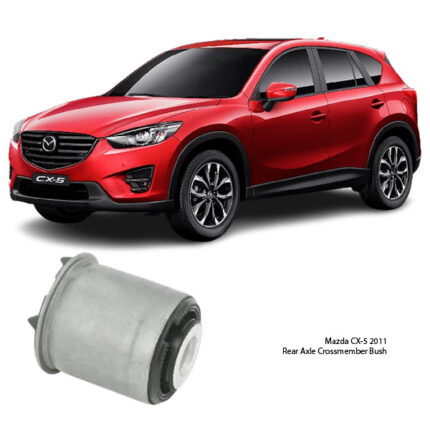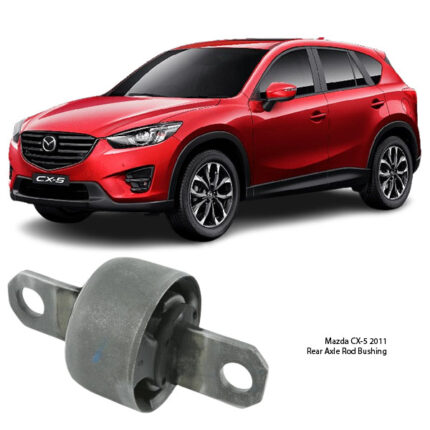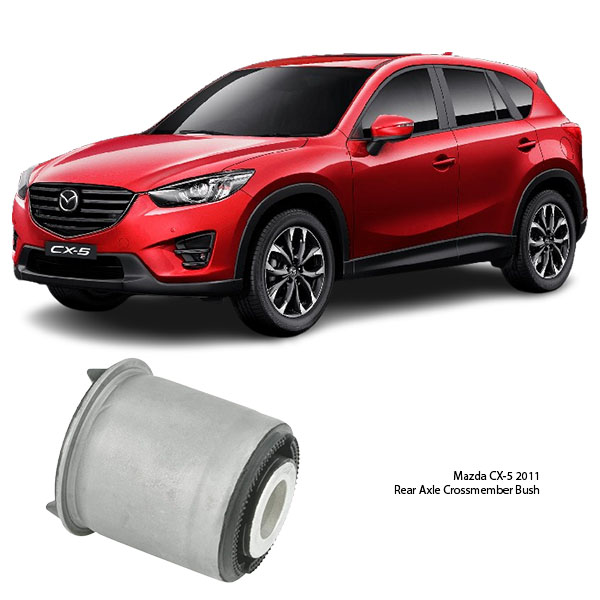-17%
Get Mazda CX-5 2011 Rear Axle Crossmember Bushing MZAB-160 in Kenya
The rear axle crossmember bushing is a critical component in a vehicle’s suspension system. It helps in maintaining stability, reducing vibrations, and ensuring a smooth ride by connecting the rear axle crossmember to the vehicle’s chassis. Though small in size, this bushing plays a significant role in the overall handling and comfort of the vehicle. In this detailed explanation, we will explore its function, benefits, maintenance tips, and common issues that arise with this component.
What is a Rear Axle Crossmember Bushing?
A rear axle crossmember bushing is a cylindrical or donut-shaped component made of rubber, polyurethane, or other resilient materials. It is designed to absorb shocks, vibrations, and movement between the rear axle crossmember and the vehicle’s chassis. The rear axle crossmember itself is a structural component that supports the rear suspension, ensuring that forces from the road are distributed evenly to maintain stability. The bushing acts as a buffer between metal components, preventing direct contact and reducing wear.
Functions of a Rear Axle Crossmember Bushing
1. Absorbing Vibrations and Road Shocks
One of the main functions of the bushing is to absorb road shocks and vibrations that occur due to uneven surfaces, potholes, or speed bumps. Without a properly functioning bushing, these shocks would be directly transferred to the chassis, causing discomfort and increased stress on other suspension components.
2. Enhancing Stability and Control
The rear axle crossmember bushing helps keep the rear suspension system stable, preventing excessive movement and misalignment. It maintains proper wheel alignment and suspension geometry, which enhances control during braking, acceleration, and cornering.
3. Reducing Noise and Harshness
Since the bushing acts as a cushion between the metal components of the crossmember and the chassis, it helps in reducing noise, vibration, and harshness (NVH). This contributes to a quieter and more comfortable ride, especially on rough terrain.
4. Preventing Metal-to-Metal Contact
If the rear axle crossmember was directly attached to the chassis without a bushing, the metal-on-metal contact would cause excessive wear, corrosion, and noise. The bushing prevents these issues by creating a flexible yet durable barrier.
5. Enhancing Suspension Longevity
By absorbing the stresses and movements of the rear suspension system, the bushing helps in reducing wear and tear on other suspension components, such as control arms, shocks, and springs. This extends the lifespan of the suspension system and reduces the need for frequent repairs.
Types of Rear Axle Crossmember Bushings
1. Rubber Bushings
Rubber bushings are the most common type found in factory-installed suspension systems. They provide excellent vibration damping and are cost-effective. However, they tend to wear out faster, especially under harsh driving conditions.
2. Polyurethane Bushings
Polyurethane bushings are more durable than rubber bushings and provide better resistance to heat, chemicals, and road debris. However, they can be slightly firmer, which may result in a stiffer ride with increased road feedback.
3. Solid Bushings (Metal or Hybrid)
Some high-performance vehicles use solid bushings made from metal or hybrid materials. These bushings provide maximum rigidity and control but sacrifice comfort since they do not absorb vibrations as effectively as rubber or polyurethane bushings.
Common Symptoms of a Worn or Failing Rear Axle Crossmember Bushing
1. Increased Road Noise and Vibrations
If the bushing is worn out or damaged, the vibrations from the road will no longer be absorbed properly, leading to a noisier and rougher ride.
2. Clunking or Knocking Noises
A failing bushing may cause clunking or knocking sounds, especially when driving over bumps or accelerating and braking. This noise results from excessive movement of the rear axle crossmember.
3. Poor Handling and Steering Response
Since the bushing plays a role in stabilizing the rear suspension, a worn-out bushing can lead to poor handling, increased body roll, and reduced steering precision. The vehicle may feel less controlled, especially during high-speed maneuvers.
4. Uneven Tire Wear
A worn bushing can cause misalignment in the rear suspension system, leading to uneven tire wear. If you notice that the rear tires are wearing out more quickly on one side, it could be due to a deteriorated crossmember bushing.
5. Excessive Rear-End Movement
When accelerating or braking, the rear of the vehicle may feel loose or unstable. This excessive movement is a sign that the bushings are no longer holding the rear axle crossmember firmly in place.
Causes of Rear Axle Crossmember Bushing Wear
1. Age and Natural Wear
Over time, bushings naturally degrade due to exposure to heat, road debris, and constant movement. Rubber bushings tend to dry out and crack as they age.
2. Harsh Driving Conditions
Driving on rough roads, hitting potholes, and carrying heavy loads can accelerate the wear of bushings. High-performance driving also puts extra stress on the suspension components.
3. Exposure to Chemicals and Moisture
Exposure to road salt, oil, and other chemicals can cause rubber bushings to deteriorate faster. Moisture can also lead to corrosion of metal components surrounding the bushing.
4. Incorrect Installation or Poor-Quality Replacement Parts
If a bushing is not installed correctly or a low-quality aftermarket replacement is used, it may not function properly or wear out prematurely.
Maintenance and Replacement Tips
1. Regular Inspection
Periodically inspect the rear axle crossmember bushings for cracks, tears, or signs of excessive wear. Look for symptoms like increased vibrations, noise, or poor handling.
2. Lubrication (For Polyurethane Bushings)
If you are using polyurethane bushings, applying the appropriate lubricant can prevent squeaking and reduce friction, extending their lifespan. Rubber bushings, however, do not require lubrication.
3. Timely Replacement
If a bushing is significantly worn or damaged, it should be replaced as soon as possible to prevent further suspension issues. Neglecting a faulty bushing can lead to more expensive repairs down the line.
4. Professional Installation vs. DIY
Replacing a rear axle crossmember bushing often requires special tools and knowledge of the suspension system. While experienced mechanics may attempt a DIY replacement, it is generally recommended to have it done by a professional to ensure proper alignment and secure installation.
5. Choosing the Right Replacement Bushing
When replacing bushings, consider using OEM (Original Equipment Manufacturer) parts for compatibility and reliability. If you want better durability or performance, polyurethane or upgraded aftermarket bushings can be a good option.
Conclusion
The rear axle crossmember bushing is an essential component of a vehicle’s suspension system, ensuring stability, reducing vibrations, and enhancing overall ride comfort. Despite being a relatively small part, its condition directly impacts handling, safety, and the longevity of other suspension components. Regular inspection and timely replacement of worn bushings can prevent costly repairs and keep your vehicle performing optimally. Whether opting for rubber, polyurethane, or solid bushings, choosing high-quality replacements and proper installation will ensure a smooth and controlled ride for years to come.
Follow us on Facebook for more parts.




Reviews
Clear filtersThere are no reviews yet.